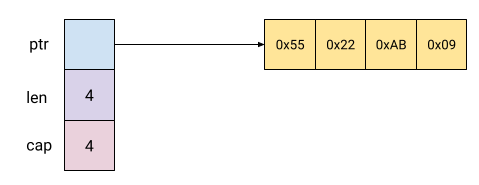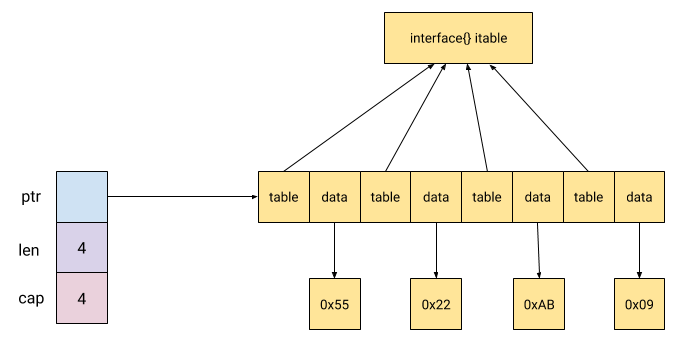为什么 Go 不支持 []T 转换为 []interface
在 Go 中,如果 interface{} 作为函数参数的话,是可以传任意参数的,然后通过类型断言来转换。
举个例子:
package main
import "fmt"
func foo(v interface{}) {
if v1, ok1 := v.(string); ok1 {
fmt.Println(v1)
} else if v2, ok2 := v.(int); ok2 {
fmt.Println(v2)
}
}
func main() {
foo(233)
foo("666")
}
不管是传 int 还是 string,最终都能输出正确结果。
那么,既然是这样的话,我就有一个疑问了,拿出我举一反三的能力。是否可以将 []T 转换为 []interface 呢?
比如下面这段代码:
func foo([]interface{}) { /* do something */ }
func main() {
var a []string = []string{"hello", "world"}
foo(a)
}
很遗憾,这段代码是不能编译通过的,如果想直接通过 b := []interface{}(a) 的方式来转换,还是会报错:
cannot use a (type []string) as type []interface {} in function argument
正确的转换方式需要这样写:
b := make([]interface{}, len(a), len(a))
for i := range a {
b[i] = a[i]
}
本来一行代码就能搞定的事情,却非要让人写四行,是不是感觉很麻烦?那为什么 Go 不支持呢?我们接着往下看。
官方解释
这个问题在官方 Wiki 中是有回答的,我复制出来放在下面:
The first is that a variable with type
[]interface{}is not an interface! It is a slice whose element type happens to be interface{}. But even given this, one might say that the meaning is clear.
Well, is it? A variable with type[]interface{}has a specific memory layout, known at compile time.
Each interface{} takes up two words (one word for the type of what is contained, the other word for either the contained data or a pointer to it). As a consequence, a slice with length N and with type[]interface{}is backed by a chunk of data that is N*2 words long.
This is different than the chunk of data backing a slice with type[]MyTypeand the same length. Its chunk of data will beN*sizeof(MyType)words long.
The result is that you cannot quickly assign something of type[]MyTypeto something of type[]interface{}; the data behind them just look different.
大概意思就是说,主要有两方面原因:
[]interface{}类型并不是interface,它是一个切片,只不过碰巧它的元素是interface;[]interface{}是有特殊内存布局的,跟interface不一样。
下面就来详细说说,是怎么个不一样。
内存布局
首先来看看 slice 在内存中是如何存储的。在源码中,它是这样定义的:
// src/runtime/slice.go
type slice struct {
array unsafe.Pointer
len int
cap int
}
array是指向底层数组的指针;len是切片的长度;cap是切片的容量,也就是array数组的大小。
举个例子,创建如下一个切片:
is := []int64{0x55, 0x22, 0xab, 0x9}
那么它的布局如下图所示:

假设程序运行在 64 位的机器上,那么每个「正方形」所占空间是 8 bytes。上图中的 ptr 所指向的底层数组占用空间就是 4 个「正方形」,也就是 32 bytes。
接下来再看看 []interface{} 在内存中是什么样的。
回答这个问题之前先看一下 interface{} 的结构,Go 中的接口类型分成两类:
iface表示包含方法的接口;eface表示不包含方法的空接口。
源码中的定义分别如下:
type iface struct {
tab *itab
data unsafe.Pointer
}
type eface struct {
_type *_type
data unsafe.Pointer
}
具体细节我们不去深究,但可以明确的是,每个 interface{} 包含两个指针, 会占据两个「正方形」。第一个指针指向 itab 或者 _type;第二个指针指向实际的数据。
所以它在内存中的布局如下图所示:

因此,不能直接将 []int64 直接传给 []interface{}。
程序运行中的内存布局
接下来换一个更形象的方式,从程序实际运行过程中,看看内存的分布是怎么样的?
看下面这样一段代码:
package main
var sum int64
func addUpDirect(s []int64) {
for i := 0; i < len(s); i++ {
sum += s[i]
}
}
func addUpViaInterface(s []interface{}) {
for i := 0; i < len(s); i++ {
sum += s[i].(int64)
}
}
func main() {
is := []int64{0x55, 0x22, 0xab, 0x9}
addUpDirect(is)
iis := make([]interface{}, len(is))
for i := 0; i < len(is); i++ {
iis[i] = is[i]
}
addUpViaInterface(iis)
}
我们使用 Delve 来进行调试,可以点击这里进行安装。
dlv debug slice-layout.go
Type 'help' for list of commands.
(dlv) break slice-layout.go:27
Breakpoint 1 set at 0x105a3fe for main.main() ./slice-layout.go:27
(dlv) c
> main.main() ./slice-layout.go:27 (hits goroutine(1):1 total:1) (PC: 0x105a3fe)
22: iis := make([]interface{}, len(is))
23: for i := 0; i < len(is); i++ {
24: iis[i] = is[i]
25: }
26:
=> 27: addUpViaInterface(iis)
28: }
打印 is 的地址:
(dlv) p &is
(*[]int64)(0xc00003a740)
接下来看看 slice 在内存中都包含了哪些内容:
(dlv) x -fmt hex -len 32 0xc00003a740
0xc00003a740: 0x10 0xa7 0x03 0x00 0xc0 0x00 0x00 0x00
0xc00003a748: 0x04 0x00 0x00 0x00 0x00 0x00 0x00 0x00
0xc00003a750: 0x04 0x00 0x00 0x00 0x00 0x00 0x00 0x00
0xc00003a758: 0x00 0x00 0x09 0x00 0xc0 0x00 0x00 0x00
每行有 8 个字节,也就是上文说的一个「正方形」。第一行是指向数据的地址;第二行是 4,表示切片长度;第三行也是 4,表示切片容量。
再来看看指向的数据到底是怎么存的:
(dlv) x -fmt hex -len 32 0xc00003a710
0xc00003a710: 0x55 0x00 0x00 0x00 0x00 0x00 0x00 0x00
0xc00003a718: 0x22 0x00 0x00 0x00 0x00 0x00 0x00 0x00
0xc00003a720: 0xab 0x00 0x00 0x00 0x00 0x00 0x00 0x00
0xc00003a728: 0x09 0x00 0x00 0x00 0x00 0x00 0x00 0x00
这就是一片连续的存储空间,保存着实际数据。
接下来用同样的方式,再来看看 iis 的内存布局。
(dlv) p &iis
(*[]interface {})(0xc00003a758)
(dlv) x -fmt hex -len 32 0xc00003a758
0xc00003a758: 0x00 0x00 0x09 0x00 0xc0 0x00 0x00 0x00
0xc00003a760: 0x04 0x00 0x00 0x00 0x00 0x00 0x00 0x00
0xc00003a768: 0x04 0x00 0x00 0x00 0x00 0x00 0x00 0x00
0xc00003a770: 0xd0 0xa7 0x03 0x00 0xc0 0x00 0x00 0x00
切片的布局和 is 是一样的,主要的不同是所指向的数据:
(dlv) x -fmt hex -len 64 0xc000090000
0xc000090000: 0x00 0xe4 0x05 0x01 0x00 0x00 0x00 0x00
0xc000090008: 0xa8 0xee 0x0a 0x01 0x00 0x00 0x00 0x00
0xc000090010: 0x00 0xe4 0x05 0x01 0x00 0x00 0x00 0x00
0xc000090018: 0x10 0xed 0x0a 0x01 0x00 0x00 0x00 0x00
0xc000090020: 0x00 0xe4 0x05 0x01 0x00 0x00 0x00 0x00
0xc000090028: 0x58 0xf1 0x0a 0x01 0x00 0x00 0x00 0x00
0xc000090030: 0x00 0xe4 0x05 0x01 0x00 0x00 0x00 0x00
0xc000090038: 0x48 0xec 0x0a 0x01 0x00 0x00 0x00 0x00
仔细观察上面的数据,偶数行内容都是相同的,这个是 interface{} 的 itab 地址。奇数行内容是不同的,指向实际的数据。
打印地址内容:
(dlv) x -fmt hex -len 8 0x010aeea8
0x10aeea8: 0x55 0x00 0x00 0x00 0x00 0x00 0x00 0x00
(dlv) x -fmt hex -len 8 0x010aed10
0x10aed10: 0x22 0x00 0x00 0x00 0x00 0x00 0x00 0x00
(dlv) x -fmt hex -len 8 0x010af158
0x10af158: 0xab 0x00 0x00 0x00 0x00 0x00 0x00 0x00
(dlv) x -fmt hex -len 8 0x010aec48
0x10aec48: 0x09 0x00 0x00 0x00 0x00 0x00 0x00 0x00
很明显,通过打印程序运行中的状态,和我们的理论分析是一致的。
通用方法
通过以上分析,我们知道了不能转换的原因,那有没有一个通用方法呢?因为我实在是不想每次多写那几行代码。
也是有的,用反射 reflect,但是缺点也很明显,效率会差一些,不建议使用。
func InterfaceSlice(slice interface{}) []interface{} {
s := reflect.ValueOf(slice)
if s.Kind() != reflect.Slice {
panic("InterfaceSlice() given a non-slice type")
}
// Keep the distinction between nil and empty slice input
if s.IsNil() {
return nil
}
ret := make([]interface{}, s.Len())
for i := 0; i < s.Len(); i++ {
ret[i] = s.Index(i).Interface()
}
return ret
}
还有其他方式吗?答案就是 Go 1.18 支持的泛型,这里就不过多介绍了,大家有兴趣的话可以继续研究。
以上就是本文的全部内容,如果觉得还不错的话欢迎点赞,转发和关注,感谢支持。
微信搜索「AlwaysBeta」,第一时间获取文章更新。
参考文章:
- https://stackoverflow.com/questions/12753805/type-converting-slices-of-interfaces
- https://github.com/golang/go/wiki/InterfaceSlice
- https://eli.thegreenplace.net/2021/go-internals-invariance-and-memory-layout-of-slices/
推荐阅读:
为什么 Go 不支持 []T 转换为 []interface的更多相关文章
- interior转换为interface
在计算的过程中,我们想要将interior(内部面)转换为interface,操作如下:
- Golang高效实践之interface、reflection、json实践
前言 反射是程序校验自己数据结构和类型的一种机制.文章尝试解释Golang的反射机制工作原理,每种编程语言的反射模型都是不同的,有很多语言甚至都不支持反射. Interface 在将反射之前需要先介绍 ...
- 浅析Go语言的Interface机制
前几日一朋友在学GO,问了我一些interface机制的问题.试着解释发现自己也不是太清楚,所以今天下午特意查了资料和阅读GO的源码(基于go1.4),整理出了此文.如果有错误的地方还望指正. GO语 ...
- jupyter notebook 目录配置、导出 tex 和 pdf 及中文支持
环境:macbook pro, mactex, jupyter notebook, brew 安装pandoc从而支持格式转换为tex: brew install pandoc 修改tex artic ...
- Golang 之 interface接口全面理解
什么是interface 在面向对象编程中,可以这么说:“接口定义了对象的行为”, 那么具体的实现行为就取决于对象了. 在Go中,接口是一组方法签名(声明的是一组方法的集合).当一个类型为接口中的所有 ...
- JAVA实现汉字转换为拼音 pinyin4j/JPinyin
在项目中经常会遇到需求用户输入汉字后转换为拼音的场景,比如说通讯录,就会要求按名字首字符发音排序,如果自己写实现这方面的功能是个很好大的工程,还好网上有公开的第三方jar支持转换,结合网上很多前辈的代 ...
- iOS开发零碎知识点
记录一些常用和不常用的iOS知识点,防止遗忘丢失.(来源为收集自己项目中用到的或者整理看到博客中的知识点),如有错误,欢迎大家批评指正:如有好的知识点,也欢迎大家联系我,添加上去.谢谢! 一.调用代码 ...
- C# 泛型的协变和逆变
1. 可变性的类型:协变性和逆变性 可变性是以一种类型安全的方式,将一个对象当做另一个对象来使用.如果不能将一个类型替换为另一个类型,那么这个类型就称之为:不变量.协变和逆变是两个相互对立的概念: 如 ...
- GO语言练习:构建json 和 解析JSON 实例
本文介绍如何使用Go语言自带的库把对象转换为JSON格式,并在channel中进行传输后,并把JSON格式的信息转换回对象. 1.Go语言的JSON 库 Go语言自带的JSON转换库为 encodin ...
- Android中的动态加载机制
在目前的软硬件环境下,Native App与Web App在用户体验上有着明显的优势,但在实际项目中有些会因为业务的频繁变更而频繁的升级客户端,造成较差的用户体验,而这也恰恰是Web App的优势.本 ...
随机推荐
- Spring Boot:自定义 Whitelabel 错误页面
一.概述在本文中,我们将研究如何禁用和自定义 Spring Boot 应用程序的默认错误页面,因为正确的错误处理描述了专业性和质量工作. 2.禁用白标错误页面 首先,让我们看看如何通过将server. ...
- vue使用elementUI组件提交表单(带图片)到node后台
1.方法一(图片与表单分开,请求2次) 1.1 前台代码 // elementUI表单 <el-form ref="form" class="forms" ...
- 出现The server time zone value ‘�й���ʱ��‘ is unrecognized的解决方法
使用mybatis链接数据库时出现如下错误, The server time zone value '�й���ʱ��' is unrecognized or represents more tha ...
- C# 获取打开的EXCEL中某列的行数
背景 在通过C#操作EXCEL时 获取行数 int iRowCount = worksheet.get_Range("A65535", oMissing).get_End(MExc ...
- 配置jmeter环境变量
好记性不如烂笔头. 本文采用jmeter5.4.1版本. 1. Linux系统 1.1 将jmeter上传到安装目录并解压 jmeter5.4.1链接: https://pan.baidu.com/ ...
- ios手机键盘拉起之后页面不会回退的问题
在input输入框输入内容之后,点击完成,键盘下去了,可是页面没有回退回去,也就是页面会空出浏览器高度那一块,这个问题发现于ios手机中的微信浏览器.解决方案如下 <input type=&qu ...
- .Net6新版本的AssemblyLoadContext 加载程序集和卸载程序集
准备俩个项目 第一个是控制台 第二个项目是类库 类库项目中只有一个示例class 将类库的代码生成dll 并且设置属性为复制到输出目录 using System.Runtime.Loader; var ...
- 2022春每日一题:Day 40
题目:[NOI2010] 超级钢琴 前求出美妙值的前缀和,然后倍增处理一下前缀和的最大值,然后对于一个左端点s,他能取到右端点的只有s+l到s+r,而他的最大贡献就是s+l 到s+r的最大子段和,因此 ...
- 2022春每日一题:Day 34
题目:lowbit求和 (没有找到哪个公开题库有这个题) 题意:求数组中任意一对数的异或和的lowbit的总和. 对于异或,二进制位中两个数相等则为0,反之为1,而且此题是要求lowbit,那我们利用 ...
- 读 Clean Code,关于变量命名和可维护代码
原文见 http://mindprod.com/jgloss/unmain.html 如何写出不能维护的代码 如何程序命名 容易输入的名字.比如:Fred,asdf 单字母的变量名.比如:a,b,c, ...
